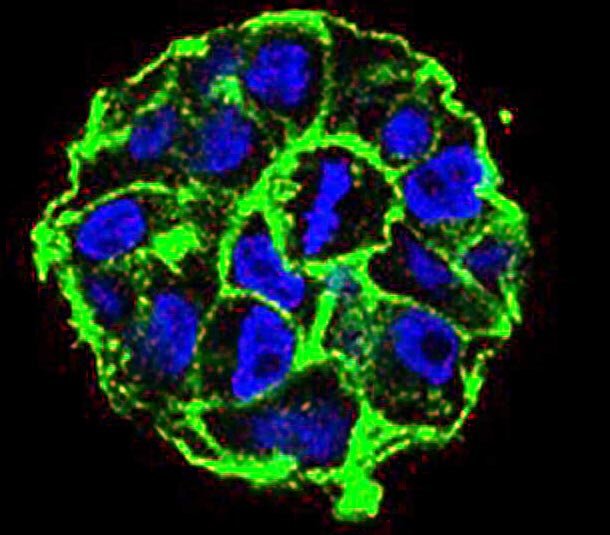Cancer research expands body’s own immune system to kill tumors

In APL Bioengineering, researchers describe how advances in engineering models of tumors can greatly expand cancer immunotherapy's effectiveness to a wider range of cancers.
This micrograph shows breast cancer cells forming a tumor spheroid when grown under 3D culture conditions.
Credit: Joanna Lee
Scientists are working to expand the way they have made immune cells fight tumors from a small handful of cancers to a wide array of them.
Scientists are hoping advances in cancer research could lead to a day when a patient’s own immune system could be used to fight and destroy a wide range of tumors.
Cancer immunotherapy has some remarkable successes, but its effectiveness has been limited to a relatively small handful of cancers. In APL Bioengineering, by AIP Publishing, a team from Stanford University and Genentech describes how advances in engineering models of tumors can greatly expand cancer immunotherapy’s effectiveness to a wider range of cancers.
“One of the biggest breakthroughs we’ve had in cancer research in decades is that we can modify the cells in your own immune system to make them kill cancer cells,” said author Joanna Lee.
Using existing immunotherapy advances, scientists have figured out a way to make the T-cells already inside “hot” or inflamed tumors start fighting them. But that breakthrough does not help with “cold” or noninflamed tumors, because the immune cells are not in the right place.
“Now, a big push in drug discovery in cancer is how do how to make those cold tumors hot?” Lee said. “How do we get immune cells into those tumors?”
To do that, scientists need to first recreate those changes in a laboratory. While much research can be done in a 2D environment, like a petri dish, modeling the way immune cells interact with cancer requires a more advanced 3D environment.
Building the tumor microenvironment, Lee said, will require expertise from both biologists, like herself, and engineers, like co-author Ovijit Chaudhuri.
“Trying to merge those two fields together is what has made the 3D culture field really challenging,” she said. “The reason it’s so hard is we are not just talking about having a plate you throw some cells in. It is more like building a house.”
A faithful 3D model for cold tumors would make the research leading to new cancer drugs faster and more efficient. Lee said that is a big deal in a field where proposed new treatments take years to be approved and an overwhelming 96.6 % of them fail.
“If we could translate the success we’ve had with inflamed tumors to cold tumors, that would be a huge breakthrough,” Lee said. “That’s what we are going for in building these 3D culture models.”
###
The article “Perspective: Modeling the tumor immune microenvironment for drug discovery using 3D culture” is authored by Joanna Y. Lee and Ovijit Chaudhuri. The article will appear in APL Bioengineering on Feb. 2, 2021 (DOI: 10.1063/5.0030693). After that date, it can be accessed at https:/
ABOUT THE JOURNAL
APL Bioengineering is an open access journal publishing significant discoveries specific to the understanding and advancement of physics and engineering of biological systems. See http://aip.
All latest news from the category: Health and Medicine
This subject area encompasses research and studies in the field of human medicine.
Among the wide-ranging list of topics covered here are anesthesiology, anatomy, surgery, human genetics, hygiene and environmental medicine, internal medicine, neurology, pharmacology, physiology, urology and dental medicine.
Newest articles

High-energy-density aqueous battery based on halogen multi-electron transfer
Traditional non-aqueous lithium-ion batteries have a high energy density, but their safety is compromised due to the flammable organic electrolytes they utilize. Aqueous batteries use water as the solvent for…

First-ever combined heart pump and pig kidney transplant
…gives new hope to patient with terminal illness. Surgeons at NYU Langone Health performed the first-ever combined mechanical heart pump and gene-edited pig kidney transplant surgery in a 54-year-old woman…

Biophysics: Testing how well biomarkers work
LMU researchers have developed a method to determine how reliably target proteins can be labeled using super-resolution fluorescence microscopy. Modern microscopy techniques make it possible to examine the inner workings…





















